By Courtney Manning
The urban education system in South Los Angeles struggles with inconsistency and faces a crisis when it comes to teacher retention. Teachers often quit their jobs within a few years and the students are left to pick up the pieces. According to a 2006 report by the Los Angeles County Children’s Planning Council, urban youth in South Los Angeles are 1.6 times as likely to face arrest and incarceration.
Why? It’s most likely that youth residing in this area live in dangerous neighborhoods and become involved with street life because they don’t have two stable household figures to motivate them academically. Because of these unstable conditions and the absence of parental guidance, many look to school as a safe haven that provides consistency.
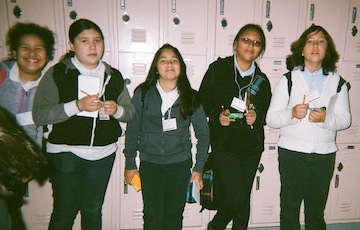
Foshay students participate in a community journalism program.
So, who is the major influence in the lives and futures of students at-risk? Experience working with the Chaka Khan Foundation Scholars Building Scholars Program, a tutoring program dedicated to the academic development of urban youth in Los Angeles, and other inner-city schools in South Los Angeles, led me to believe that it’s the teachers.
According to a 2010 Kids Count Data Center report, 42 percent of children in the Los Angeles area lived in one-parent households. The majority of these single parents either work while their child is in school, or simply don’t feel the need to stress the importance of education to their children.
When teachers give up on urban youth, everyone suffers the consequences. Long term teachers in the system see it happen often at their schools and recognize that it’s their duty to not only give their students hope, but to ensure that they succeed in life.
“Pay is never really good at the schools. That could be why teachers leave,” says Marsha Oddie, teacher of 16 years at Optimal Christian Academy in Compton. “But if you love your job, you want to be there for your students and you want them to succeed and go on to college.”
According to Off the Mat, Into the World, a non-profit that uses the power of yoga to inspire social activism, nearly one in three children in Inglewood and surrounding South LA areas live in poverty.
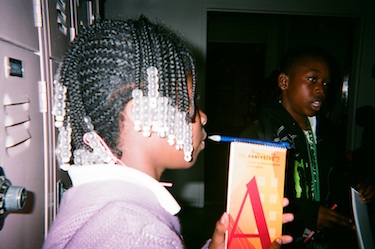
Since the family dynamics of many urban youth in Los Angeles may be unstable and faced with financial shortcomings, many students look to their schools as a solution. As a result, students often foster life-changing relationships with their teachers rather than their own parents.
Problems outside of the classroom greatly impact their experience inside the classroom, and education scholars say this is the reason why the presence of teachers is so crucial to their development.
“These students, especially in the developmental stages, need a stable role model in their life, so their teachers definitely play a greater role because they might not have that at home,” says Diane Yoon, Director of Outreach Projects for the Pullias Center for Higher Education at the University of Southern California (USC) Rossier School of Education.
Students express that they generally have low expectations for their teachers. When they do not stick around, it reinforces their expectations, leaving them feeling neglected and likely to lose hope in school altogether.
“My teacher changed two times this year. This one’s probably [going to] quit too. It makes me feel like they don’t really care that much about us and I’m just really tired of it changing,” says Anai Sai, a sixth grade student at Foshay Learning Center. Sai’s classmate, Shykeisha Ivy, shared similar concerns. “When we get a new teacher, it’s confusing. It makes me think, why do we keep switching.”
According to research on urban education done at the University of California, Los Angeles (UCLA), the shortage of qualified urban teachers often goes unnoticed. Researchers at UCLA say that the tight labor market for teachers places urban areas at a competitive disadvantage. Difficulty with keeping teachers coming back often means bringing in substitutes without credentials.
“This year we lost a teacher mid-year because they got a promotion. Now we have a long term substitute in the classroom that doesn’t have formal credentials in that subject,” says Emilio Garza, assistant principal at Foshay Learning Center.
According to the National Center for Education Statistics (NCES), teacher absenteeism is much more of a problem in urban schools than their suburban and rural counterparts. Over 50 percent of teachers in Los Angeles quit their jobs within the first three years, according to literacy research nonprofit Reading Rockets. When a teacher drops out, everyone suffers the consequences.
Garza says the school does what they can to secure permanent teachers, but having substitutes happens a lot more than he would like to see on their campus. “I would like to see more consistency from our faculty and staff in terms of attendance,” he says.
NCES research shows that student behavior problems are more common in urban schools, particularly in the areas of student absenteeism and classroom discipline—this is where teachers come into play. But involved school parents seem to think that the kids’ behavior is not the point, and that it’s the school’s responsibility to give students hope for the future.
“Sometimes they listen, sometimes they don’t, but it’s the school that needs to listen to these kids and find people who care enough to commit to the position,” says Sharon Downs, former Foshay student and now parent volunteer at the school.
Downs says you can tell when the students are affected by the lack of constancy on their school grounds. “A lot of the kids ask me, what happened to this person and this person?”
Rose Santillan, another school volunteer and grandmother of a Foshay student, also agrees that changes at the school take a toll on the students. “For these kids, changing teachers is like changing schools, because they don’t get to know them and that’s what many of them need.”
Instilling motivation in their students is a key duty for urban schoolteachers, whether that means praise, rewards, encouragement, or even punishment. Motivation in school highly affects students’ academic performance. An educational psychology study done by experts at Miami University showed that urban minority youth grow up with the mentality that their lives will eventually be restricted and feel unable to meet others’ expectations, including those of their teachers.
When teachers truly love their job, it reflects on the students and they are more likely to go to college. A study from the New York Times this year suggested that having a good teacher makes a student nearly two percent more likely to go to college, while having a poor teacher is equivalent to the student missing 40 percent of the entire school year.
“Even though I have kinder kids, the ones that go off to college have come back to let me know how they’re doing—they hadn’t forgotten about me,” says Compton schoolteacher Marsha Oddie. “It feels good because I know that I made a difference in a child’s life.”
According to the NCES, about 35 percent of the Los Angeles population that is 25 years and over have completed high school as their highest level of education. It is apparent that urban students feel that their teachers are neither present nor patient enough with their level of understanding and opt for skipping class. These same students often resort to giving up on education altogether.
In a study investigating student failure in urban schools, “teacher absenteeism and the lack of personal relationships with teachers” were found to be the main reasons for student dropouts. Whether schools need to make more of an effort to adequately screen incoming teachers, inconsistency in the teaching staffs are putting urban youth at more of a disadvantage than they already are.









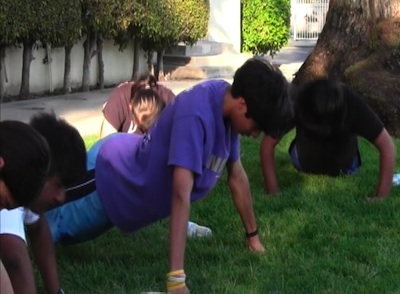 It’s 6:30 a.m. on a mid-March Saturday morning—not the usual time for students to be arriving to their high school campus. Yet one by one they come: some yawning, others munching on a hurried breakfast, all ready to run.
It’s 6:30 a.m. on a mid-March Saturday morning—not the usual time for students to be arriving to their high school campus. Yet one by one they come: some yawning, others munching on a hurried breakfast, all ready to run.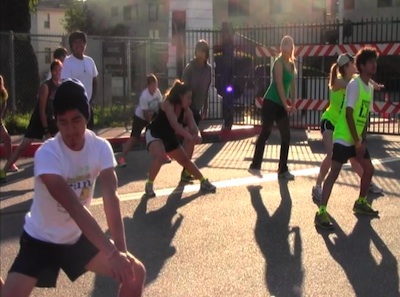 Foshay’s 10 student runners are part of a larger group of 3,000 students from 165 Southern California high schools, middle schools and community programs that train to run the marathon each year as a part of the Students Run L.A. (SRLA) program.
Foshay’s 10 student runners are part of a larger group of 3,000 students from 165 Southern California high schools, middle schools and community programs that train to run the marathon each year as a part of the Students Run L.A. (SRLA) program.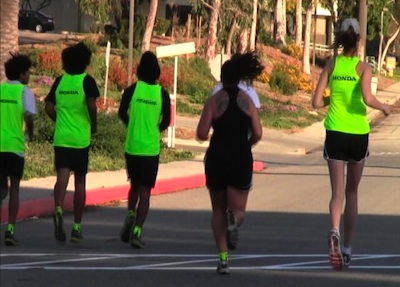 Less than 45 minutes after they set out from Veterans Park, the runners start to arrive at the designated meeting place, a grassy area overlooking the ocean near the Santa Monica Pier.
Less than 45 minutes after they set out from Veterans Park, the runners start to arrive at the designated meeting place, a grassy area overlooking the ocean near the Santa Monica Pier. At first glance, 13-year-old Jasmine Taylor resembles the quintessential middle school student.
At first glance, 13-year-old Jasmine Taylor resembles the quintessential middle school student. Midby and his students continue to lead a number of art workshops in South Los Angeles, teaching children and community members how to make recycled art and silkscreen original designs on T-shirts. In the classroom, Midby is part-teacher and part-producer, giving his students the agency halfway through the school year to plan their own class time. Midway through school year, Midby’s five classes are far beyond strict lesson plans.
Midby and his students continue to lead a number of art workshops in South Los Angeles, teaching children and community members how to make recycled art and silkscreen original designs on T-shirts. In the classroom, Midby is part-teacher and part-producer, giving his students the agency halfway through the school year to plan their own class time. Midway through school year, Midby’s five classes are far beyond strict lesson plans. “Whether they publish this in the L.A. Times or not, every good teacher hates the fact that the union protects lousy teachers… hates it,” Midby said. “Why should the ones of us who work so hard have to see and work with other people who obviously don’t care?”
“Whether they publish this in the L.A. Times or not, every good teacher hates the fact that the union protects lousy teachers… hates it,” Midby said. “Why should the ones of us who work so hard have to see and work with other people who obviously don’t care?”
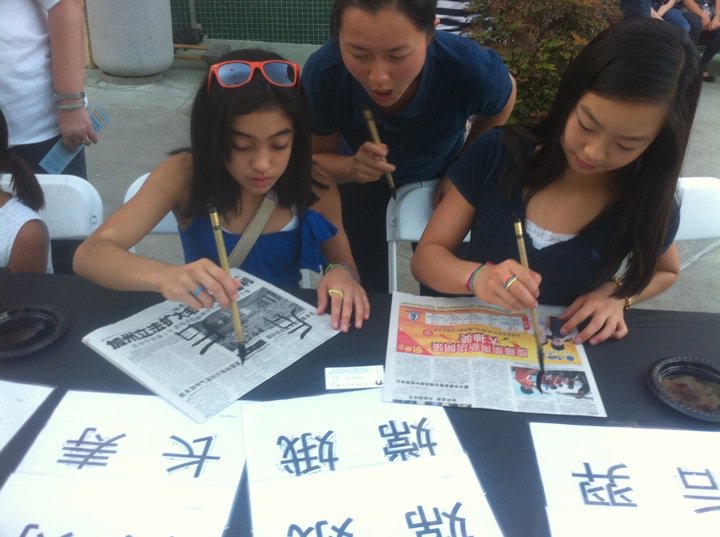 Seated in a folding chair in the middle of Chinatown’s historic West Plaza, seven-year-old Aidan Garner’s short legs dangled his little feet above the ground as a concentrated expression washed over his face. He dipped a calligraphy brush almost as long as his whole arm into a bowl of black paint, and meticulously copied a series of connected lines from the paper beside him onto the newspaper in front of him. As an American-born, second-grade student, Garner had just done something that most American adults will never be able to do: he had written the Mandarin Chinese character for ‘moon cake’. As his mother looked proudly over his shoulder smiling, Garner declared, “I’m writing Chinese, it’s fun and easy!”
Seated in a folding chair in the middle of Chinatown’s historic West Plaza, seven-year-old Aidan Garner’s short legs dangled his little feet above the ground as a concentrated expression washed over his face. He dipped a calligraphy brush almost as long as his whole arm into a bowl of black paint, and meticulously copied a series of connected lines from the paper beside him onto the newspaper in front of him. As an American-born, second-grade student, Garner had just done something that most American adults will never be able to do: he had written the Mandarin Chinese character for ‘moon cake’. As his mother looked proudly over his shoulder smiling, Garner declared, “I’m writing Chinese, it’s fun and easy!”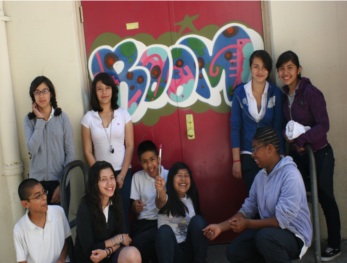 On Saturday, March 13, artists from ROOM 13, a student-run art studio at James Foshay Learning Center, are participating in a joint-exhibit with other students from local school districts.
On Saturday, March 13, artists from ROOM 13, a student-run art studio at James Foshay Learning Center, are participating in a joint-exhibit with other students from local school districts.




